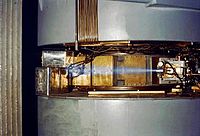
Photo from wikipedia
PURPOSE This paper investigates the feasibility of implementing a predictive maintenance program for a multileaf collimator (MLC) based on data collected in trajectory logs (TLs) obtained by conducting a simple… Click to show full abstract
PURPOSE This paper investigates the feasibility of implementing a predictive maintenance program for a multileaf collimator (MLC) based on data collected in trajectory logs (TLs) obtained by conducting a simple daily test, with the aim of minimizing unscheduled downtime. METHODS A dynamic field test was designed, and the TLs generated in the course of daily administration in a linear accelerator were collected to evaluate trajectory deviations of the MLC leaves as well as interlocks (COL 420219/20, COL 420207/08) reported by the machine. During this evaluation we observed that the trajectory deviations of some leaves increased up to a threshold value beyond which certain interlocks began to appear in treatment fields in those leaves. An exponential degradation model was therefore developed to predict this drift and determine each leaf's remaining useful life (RUL). Once the applicability of the model was confirmed, we added a second accelerator equipped with an MLC with the same configuration to validate the model. RESULTS The model was able to predict certain COL 420219/20 interlocks resulting from primary readout/ expected position discrepancies and to estimate each leaf's RUL. In total, 11 cases (8 interlocks + 3 potential interlocks avoided due to service interventions (27,3% of the total)) were detected over 7 days in advance, with no false positive results. Scheduling of service interventions several days prior to MLC failure would therefore be possible. When this type of interlocks were not predicted by the model, they were always generated by leaf motor failure. Consequently, intervention time could also be optimized by directly replacing the motor. During the study period, for this type of interlocks, our approach would have reduced downtime from 35.25 h to 4.00 h (88.7%) and from 34.75 h to 22.83 h (34.3%) for each accelerator, respectively. For COL 420207/08 interlocks, which are generated by primary/secondary readout discrepancies, no correlation with leaf trajectory deviation increases recorded in the TLs was found. Throughout the study period, this type of interlocks requiring service intervention, also mainly for motor replacement, represented a downtime of 9.50 h for the first accelerator (21.2% of total downtime) and by 4.33 h (11.1% of total downtime) for the second accelerator. CONCLUSION This study demonstrates that by applying a predictive MLC maintenance program based on information collected in TLs, it is possible to predict certain interlocks and therefore schedule preemptive interventions to avoid their occurrence. This could optimize healthcare delivery performance and minimize the loss of treatment sessions. This article is protected by copyright. All rights reserved.
Journal Title: Medical physics
Year Published: 2022
Link to full text (if available)
Share on Social Media: Sign Up to like & get
recommendations!